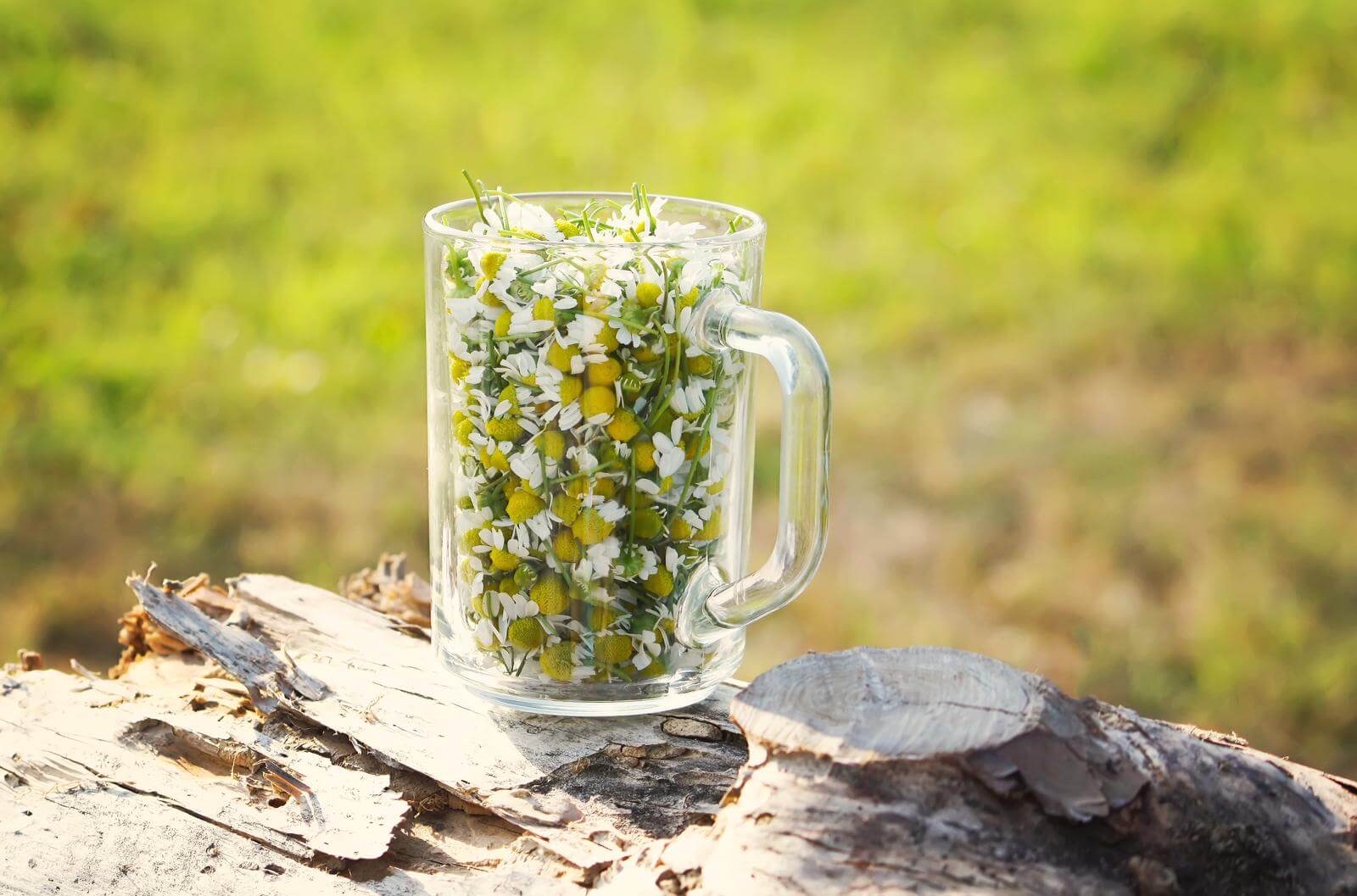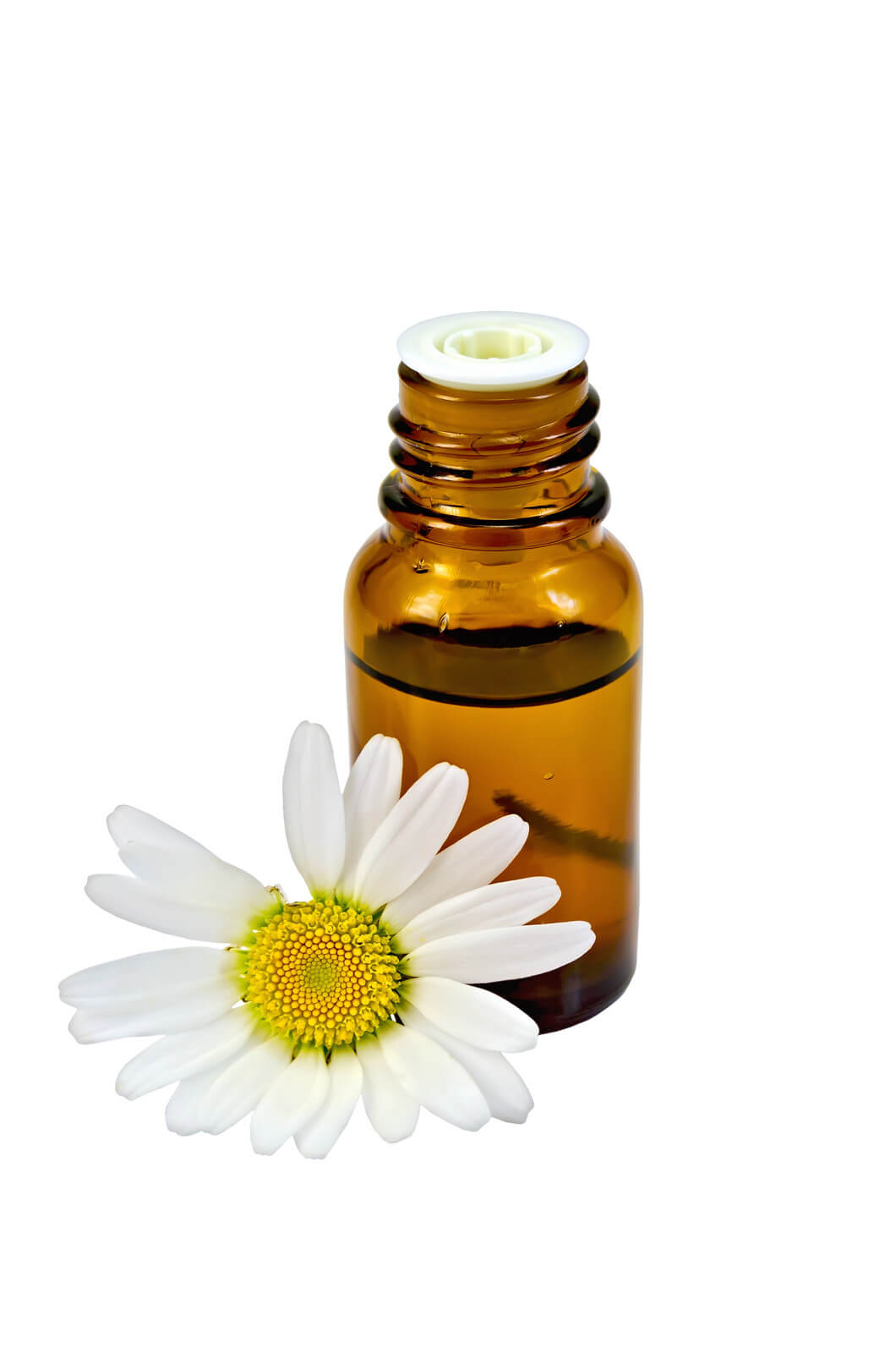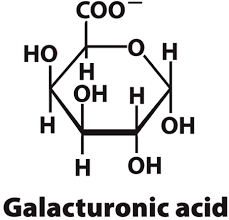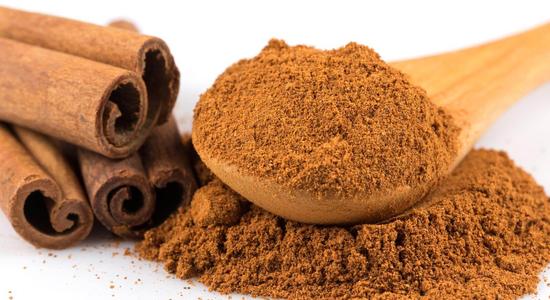See all "Herbs" Section Topics

Chamomile (Matricaria recutita / Matricaria chamomilla) is a great choice for an herbal yeast infection remedy. This plant has several antifungal compounds present in it that deliver a powerful blow to Candida (Candida is the yeast that causes yeast infections).
Using chamomile medicinally is not a new idea; this herb has been used by physicians for thousands of years. The ancient Egyptians, Romans, and Greeks all used chamomile to treat a wide variety of health maladies. You can also use this helpful herb quickly and easily to get rid of a yeast infection!
One caveat to remember, is that this herb’s scientific name Matricaria recutita also has the alias Matricaria chamomilla; hence, these two names indicate the same herb—German Chamomile.
Murti, Krishna, et al. state that chamomile has a wide variety of medicinal uses. Apparently, a number of the chemical constituents of this herb are excellent at stopping various bacteria, fungi, and viruses. The authors state the following about the antimicrobial efficacy of chamomile:
The antibacterial and antiviral effects of chamomile have been well documented (Aggag and Yousef, 1972). An ethanolic extract of German chamomile inhibited the growth of Herpes and Polio Virus (Suganda et al.,1983). Compounds in the essential oil of chamomile were effective against Staphylococcus and Candida. Chamomile's essential oil components, α-bisabolol had the strongest activity against Gram-positive and Gram-negative bacteria. Chamazulene also had strong antimicrobial activity.
http://dx.doi.org/10.5567/pharmacologia.2012.348.351
Of the phytochemicals present in Chamomile, many are efficacious antifungal compounds. The following antifungal compounds present in chamomile were identified by Dr. James Duke’s phytochemical database. These chemicals give chamomile its potent ability to kill off a yeast infection. The chemicals include:
- Alpha-Bisabolol
- Beta-Sitosterol
- Borneol
- Caprylic acid
- Geraniol
- Herniarin
- Perillyl alcohol
- Quercetin
- Umbelliferone
A 1/2 Day & Yeast is Gone!
Linda Allen suffered from yeast infections for years. Through researching natural medicine & Candida, she found an efficacious solution!
Linda is one expert you want on your side! Let her show you how to get rid of a superficial yeast infection in just 12 hours; AND, keep it gone!
A 60-day, 100% money back guarantee is provided.
Visit Official Site!The Right Kind of Chamomile for Candida

There are many names for chamomile and it is important you get the right kind to use. The correct species of chamomile to use for yeast infections is Matricaria chamomilla—also known as Matricaria recutita. If you examine the studies cited in this article, please note that they sometimes refer to Matricaria recutita and Matricaria chamomilla—again, these are both the same plant. Some of the common names of the right kind of Matricaria recutita include the following names:
- Annual Chamomile
- German Chamomile
- Wild Chamomile
Another species of chamomile, Chamaemelum nobile, is also known as chamomile. This species is probably not as good as Matricaria recutita for treating a yeast infection. There may be more carbohydrates in Chamaemelum nobile; making it less desirable for use against Candida yeast. This plant is also in the Asteraceae family, and the common names for it include the following:
- Garden Chamomile
- Perennial Chamomile
- Roman Chamomile
Eliminate Bacterial Vaginosis & Vaginal Odor
Jennifer O’Brien is one prominent expert on BV that knows how to get rid of vaginal odor. BV is a common infection that you don’t have to put up with.
Jennifer will show you how to naturally eliminate vaginal odor in just 3 days.
A 60-day, 100% money back guarantee is provided.
Visit Official Site!How to Use Chamomile for Yeast Infections

A great way to use chamomile for yeast infections is to make a tea with the dried herb. Simply take a few scoops of dried chamomile and boil it in a few cups of water. Strain the herb out if you didn’t use a tea bag, and you’ve made chamomile tea!
Once the tea is made, you can drink it several times a day to help allay intestinal yeast infections. Also, take some chamomile tea and use it topically in the vagina by applying it with a cotton ball or clean cloth. You can also use the tea as a douche to target vaginal yeast infections.
Try adding a few drops of other plant essential oils that also kill Candida to improve the power of your remedy. You can place some of the dried herb in a sitz bath as well! For products containing chamomile, just follow the directions on the package.
If you have a few bags of chamomile that are typically used for making a tea, you can also soak them in a little water and insert them into the vagina. Try using a chamomile tea bag as a vaginal suppository overnight to combat yeast infections.
If you have some dried chamomile, you can add it to honey and use the mixture intravaginally. For more information on items to add to you chamomile cure, check out these pages:
Clair Goodall: Author & Nature Lover
Clair Goodall is a bee-obsessed natural medicine convert from Minnesota. She is one expert you might want to know more about!
Clair will help you protect you and your family from toxic products and chemicals and help you discover solutions from nature.
Also, Clair’s book is backed by a 60-day, 100% money back guarantee
Visit Official Site!Research on the Antifungal Properties of Chamomile

The first study we will examine was published in Revista Brasileira de Otorrinolaringologia [74.1 (2008): 118-124]. The journal’s study was conducted with a few different herbs and evaluated the essential oil of these herbs on various microorganisms. Of these microorganisms studied, Candida albicans and Candida krusei were among the fungal pathogens examined.
The study found that Matricaria chamomilla exhibited a strong inhibitory action against both Candida species. A concentration of 4% essential chamomile oil was enough to inhibit Candida albicans and Candida krusei.
Another study, of how efficacious chamomile extracts are at hindering the development microorganisms, was published in Industrial Crops and Products [44 (2013): 437-445]. The study looked at both bacteria and fungi; of these fungi, one was Aspergillus flavus and the other was Candida albicans.
The study used various chemical solvents to extract the phytochemicals in chamomile; in total 4 different solvents were used. Once the extracts were created, they were tested on the organisms. Chamomile in all the different solvents inhibited all the bacteria and fungus it was tested on.
The study found that just a few micrograms of each chamomile extract successfully inhibited Candida albicans. Consequently, using this herbal remedy is proven to be a good choice.
Galacturonic Acid in Matricaria recutita Chamomile

Of the varieties of chamomile that are available, Matricaria recutita contains a significant amount of galacturonic acid that is not present in another popular variety of chamomile: Chamaemelum nobile. This lack of galacturonic acid may be of significance to victims of Candida infection as one study suggests.
The study relating to galacturonic acid was published in Planta Medica [67.5 (2001): 428-431]. In the study, many mice were injected with lethal doses of Candida albicans. The mice were examined for survival. One group of mice was given chemicals from an herb and studied to see if any positive effects on survival would result.
The study found that a fraction of this herb, containing about 80% galacturonic acid, aided the survival of the mice infected with Candida. To achieve these results, mice were given 17.5 mg per kilogram of body weight daily of this fraction. Since this fraction contained mostly galacturonic acid, it is likely to assume this acid played an important role in aiding mice survival.
This suggests that taking galacturonic acid, which is naturally present in Matricaria recutita flowers, may also help the body of humans deal with Candida yeast.
According to Dr. James Duke’s phytochemical database, there are about 750,000 ppm of galacturonic acid present in Matricaria recutita flowers. Thus, there is about 749 mg of galacturonic acid in each milliliter of this type of chamomile flowers. Using the same metric of dosage used in the aforementioned study, this would mean each milliliter of chamomile will be enough for about 90lbs (40kg) of body weight.
You should be able to get more than enough galacturonic acid in chamomile tea to perhaps see some beneficial results—assuming it contains a decent amount of the plant’s flowers. Just make sure you're not using the wrong species of chamomile!
Chamomile Side Effects
Chamomile belongs to the Asteraceae family; commonly referred to as the compositae, aster, daisy, or composite family. Consequently, it can share some commonalities with other plants in this family like ragweed, marigold, daisy, and chrysanthemum.
If you have had a history of allergic reactions to ragweed, or other plants in this family, you may also have an allergic response to chamomile as well. This is the most probable side effect that can occur when taking chamomile.
Allergic reactions include skin rashes, shortness of breath, throat swelling, and even anaphylaxis. This occurs when people who are allergic come into contact with chamomile or ingest it. If you are concerned you may be allergic to chamomile, you can do a quick test to see how your body reacts. Simply make a strong tea or decoction of chamomile and place a little bit on a patch of skin.
If your skin develops a rash, you should discontinue use. If you do not see any adverse effects, you can try drinking a little of the tea; then, watch to see if you notice any allergic reactions.
If you have a history of severe allergic reactions to these types of plants, it would be prudent to consult a physician about your plan to use this medicinal herb. Also, you can avoid taking chamomile tea or any other preparation intended for ingestion. Limit your use of chamomile to topical treatments and you are going to be less at risk for systemic side effects due to allergic reaction.
A Natural, 12 Hour Yeast Infection Cure

According to a research paper published in Clinical Microbiology Reviews [12.1 (1999): 80-96], Candida species are quite ubiquitous organisms. Candida are most frequently present in the mouth; and, live in 31% to 55% of healthy people. The species that causes approximately 70% to 80% of all Candida infections is C. albicans.
The Chinese Journal of Obstetrics and Gynecology [2011 Jul;46(7):496] reports there appears to be a correlation between intestinal Candida infections and vaginal yeast infections. And, this provides a clue, as to why yeast infections in general, can reoccur.
This study states, in 148 cases of vaginal candida infections, 33.1% of the women were infected in both the intestines and vaginal area. The recurrence rate of yeast infections, in women with simultaneous intestinal infection, was significantly higher than for women who did not have an intestinal infection.
This study concluded that vaginal yeast infections are highly associated with simultaneous intestinal Candida infection.
As research appears to indicate, systemic Candida infections can and do happen. A more systemic Candida infection may primarily get a foothold in the intestines; and cause a wide array of problems. If your yeast infections keep happening, a systemic Candida problem may be why.
One woman who suffered from a systemic Candida infection, for about 12 years, was Linda Allen. The systemic Candida infection that attacked Linda caused a wide range of health problems in addition to yeast infections. Some of these problems, Linda describes in her own words in the following quote:
To be honest, it was hard to pinpoint exactly what was wrong: I wasn’t really sick, but I wasn’t really well either. I had listlessness, fatigue, brain fog, stomach ailments, unexplained rashes, skin infections, and so on. It seemed like every day brought a new challenge.
My energy was sapped and I felt exhausted, which affected my grades and put a big dent in my social life.
Linda Allen’s symptoms included an embarrassing vaginal discharge, severe itching, and burning sensations. Her infections were difficult to deal with, and Linda’s health problems cost her financially as well. Linda states these infections of Candida can become excruciating when they happen as frequently as a menstrual period.
Yet, Linda spent a great deal of time in research; and even questioned health professionals who were kind enough to share some time with her. Linda even tried an array of purported "cures." Although it took a while, eventually, Linda put together a natural treatment plan she hoped would solve her Candida situation.
After spending about a year refining her new approach, Linda tried her system on herself. It worked amazingly well. Linda even returned to a few medical doctors to get tested for the presence of infections. These tests revealed all indicators of infection had vanished! Linda was indeed well again, after such a long, difficult journey.
Linda has since published a book detailing how to copy her success. She also includes a 12 hour yeast infection cure that can get rid of a superficial (such as a genital yeast infection or oral thrush) yeast infection in about 12 hours.
Linda’s publisher protects those who get her book with a 60 day, 100% money back guarantee. Linda’s publisher, a subsidiary of the United States based firm Keynetics Incorporated, is a reputable digital retailer that has been around for a long time.
They have great customer service, and make getting a full refund on Linda’s book quick and easy. If you’re not satisfied, you can quickly get all your money back.
If you would like to learn more about Linda’s journey to freedom from Candida, see reviews of others who tried her natural system, or find out more about her efficacious book; you can find more information at Linda Allen’s website.
Author: Mr. Nicholas Gross

Nick Gross is a natural medicine enthusiast who has been researching and writing about natural medicine since 2008. Nick is primarily a web developer but also researches and authors written and video content about natural health. Nick has a bachelor’s degree in Management Information Systems from the University of Northern Iowa.
Disclaimer
The information on this website is not a prescription for anyone. This information is for informational or educational purposes only, and is not a substitute for professional medical advice or consultations with healthcare professionals.
Affiliate Disclosure
Some of the links provided on this website are affiliate links. When a purchase is made through these links, Candida Hub earns money from commission. This helps to keep the website up and helpful to people for free. Thank you for any support!
Stay Up to Date
If you enjoyed this article, consider following / liking our Facebook page. This page is primarily utilized to alert followers of new articles that are put on Candida Hub. Candida related news is also discussed. While you are there, you can see what has been more recently added to Candida Hub.
SOURCES:
- https://umm.edu/health/medical/altmed/herb/german-chamomile — German chamomile fact sheet
- http://dx.doi.org/10.5567/pharmacologia.2012.348.351 — Murti, Krishna, et al. "Pharmacological properties of Matricaria recutita: a review." Pharm 3.8 (2012): 348-351.
- http://dx.doi.org/10.1590/S0034-72992008000100019 — Nogueira, Janaina Cândida Rodrigues, Margareth de Fátima Melo Diniz, and Edeltrudes O. Lima. "In vitro antimicrobial activity of plants in Acute Otitis Externa." Revista Brasileira de Otorrinolaringologia 74.1 (2008): 118-124.
- http://dx.doi.org/10.1016/j.indcrop.2012.10.012 — Roby, Mohamed Hussein Hamdy, et al. "Antioxidant and antimicrobial activities of essential oil and extracts of fennel (Foeniculum vulgare L.) and chamomile (Matricaria chamomilla L.)." Industrial crops and products 44 (2013): 437-445.
- http://dx.doi.org/10.1055/s-2001-15822 — Inagaki, Nobuyuki, et al. "Acidic polysaccharides from rhizomes of Atractylodes lancea as protective principle in Candida-infected mice." Planta medica 67.5 (2001): 428-431.
- Dr. Duke's Phytochemical and Ethnobotanical Databases
- https://nccih.nih.gov/health/chamomile/ataglance.htm — Chamomile fact sheet from nih.gov
- Google Books — Duke, J. A. (1997). The green pharmacy: New discoveries in herbal remedies for common diseases and conditions from the world's foremost authority on healing herbs. Emmaus, Pa: Rodale Press.
- https://doi.org/10.1128/CMR.12.1.80 -- Fidel, Paul L., Jose A. Vazquez, and Jack D. Sobel. "Candida glabrata: review of epidemiology, pathogenesis, and clinical disease with comparison to C. albicans." Clinical Microbiology Reviews [12.1 (1999): 80-96].
- https://pubmed.ncbi.nlm.nih.gov/22041440/ -- Lin XL, Li Z, Zuo XL. "Study on the relationship between vaginal and intestinal candida in patients with vulvovaginal candidiasis." Chinese Journal of Obstetrics and Gynecology (Zhonghua fu chan ke za zhi). [2011 Jul;46(7):496].







